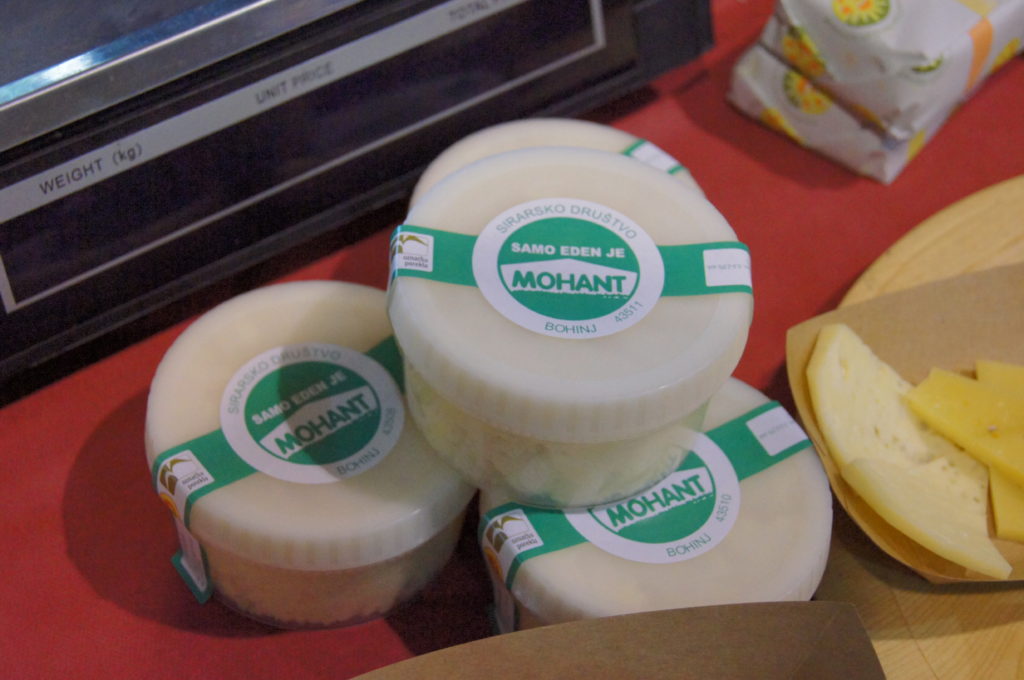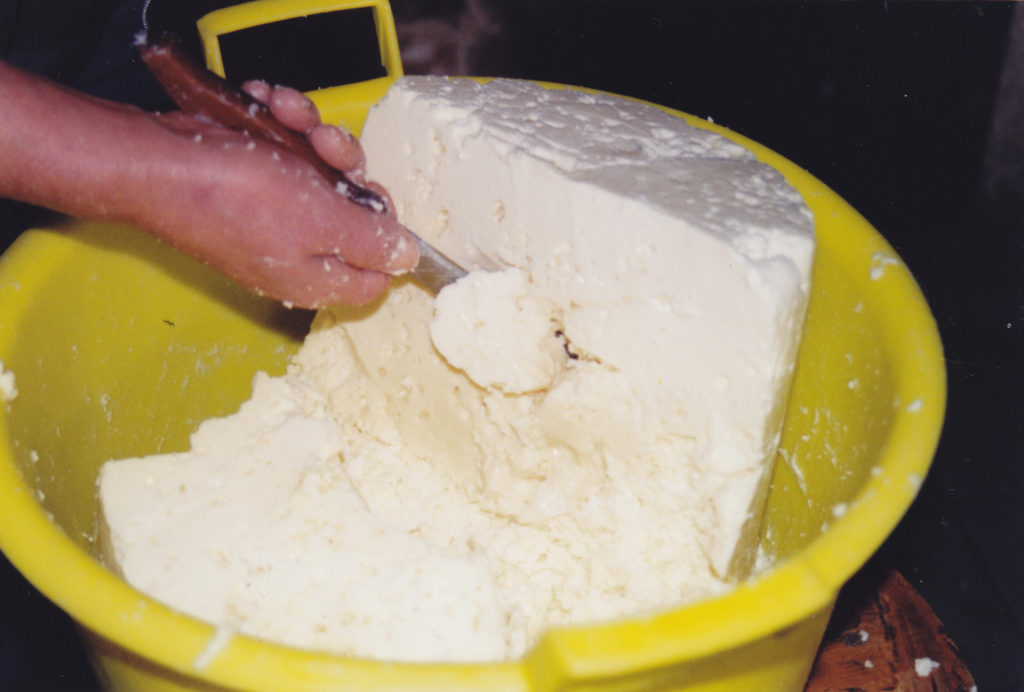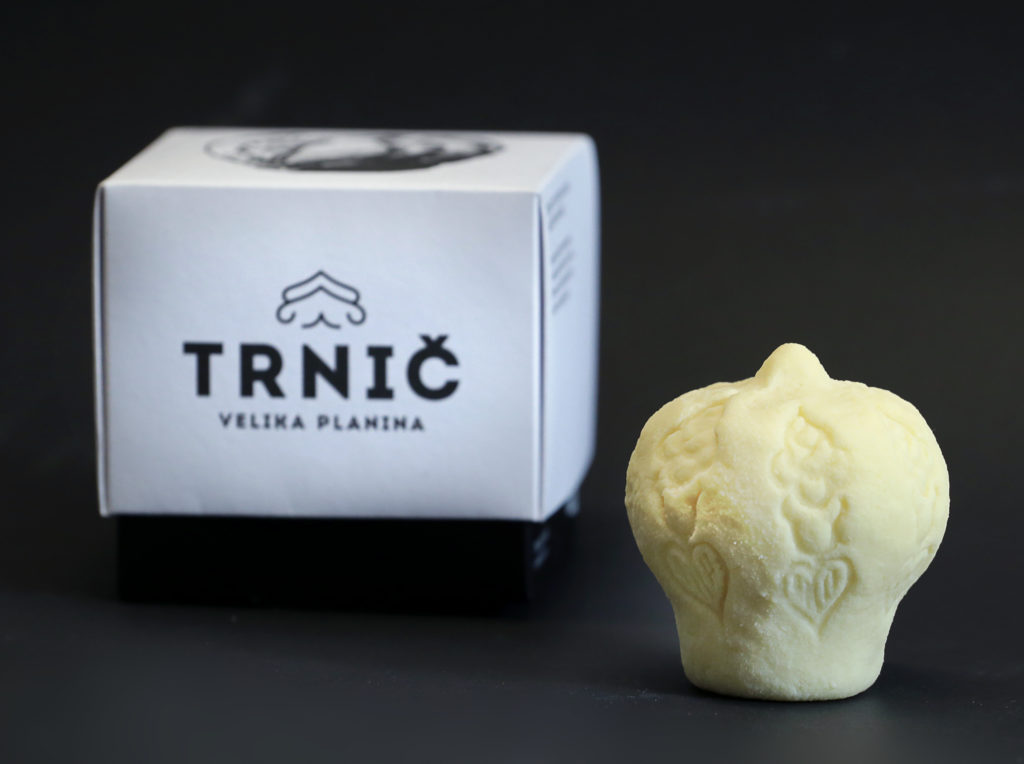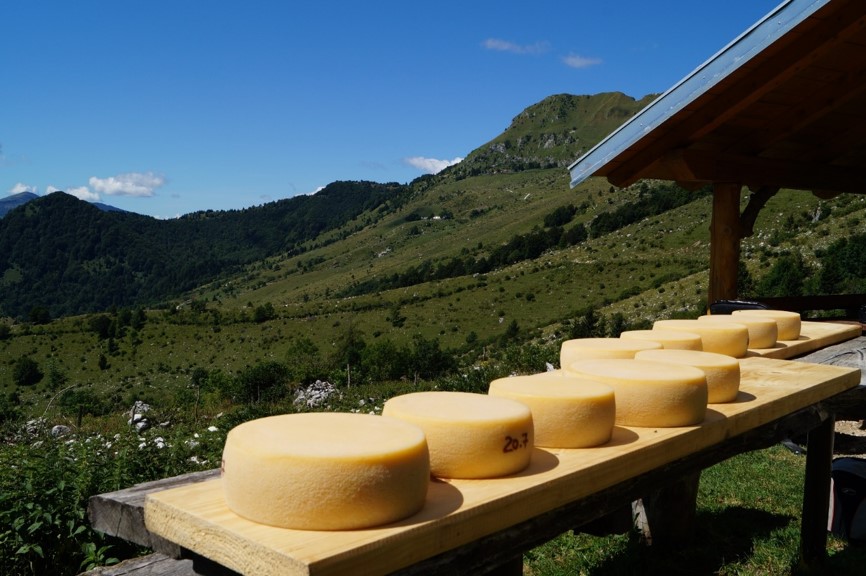Mohant, Trnič and Tolminc Cheese: a heritage of alpine cheese-making?
One wild man got drunk so they could tie him up. He asked them to let him go and to tell them what could be made from the milk. He showed them how to make cheese, cottage cheese and butter. Then they let him go. When they let him go, he told them that if they had not let him go, he would have told them more.
The legend from the Soča Valley[1]
Similar stories about cheese, ricotta, butter and alcohol (the wild man did get drunk!) are widespread in the wider Alpine region and on the Apennine peninsula (Grafenauer 1958). They show the contact of Indo-European immigrants with the pre-Indo-European populations from whom cheese-making skills were first acquired. Archaeological sources point to milk processing in north-eastern and south-eastern Europe between as early as 5500 and 5000 BC (McClure et al. 2018), in the Alpine areas around 4000 BC, and in the high mountain areas of the Central and Eastern Alps in the first millennium BC (Carrer et al. 2018). As a result, the Iron Age inhabitants of present-day Slovenia already knew the technology of processing milk into products that could be transported, stored and then consumed over the winter or traded. Archaeological finds of the cheese models in the Julian Alps also provide evidence of existing dairying knowledge in the Roman era (Cevc 2006; Mlinar 2019). From the Romanised indigenous peoples, the dairying knowledge was most likely taken over by Slavic immigrants, who arrived in the area of present-day Slovenia in several waves from the second half of the 6th century onwards (Novak 1961; Cevc 2006).
The earliest written sources mentioning cheese date back to the 12th and 13th centuries (Kos 1948: 30). However, dairying and cattle breeding became the main agro-economic industries in the second half of the 19th century, when individual milk processing, mainly butter-making, was replaced by cooperative milk processing under the supervision of a trained cheese-maker (Valenčič 1990; Ledinek Lozej 2012). After the Second World War, milk processing was centralised in the central industrial dairies in Tolmin (later Kobarid), Srednja vas in Bohinj, Kranj, Škofja Loka and Ljubljana. Initially this was to oversee the compulsory delivery of milk but later it shifted to the organisation of milk purchase and collection. Now though, this once vital way of life and livelihood survives, thanks only to preservation. Nevertheless, its strategic survival has co-shaped the imaginaries of ‘traditional’ and ‘local’ (market) products and of food heritage in the 21st century.
The food product qualification and (re)localisation, traditionaliation and heritagisation of food and foodways are intertwined processes and are in fact not exclusively linked to the last decade of accelerated food branding. Geographical indications were already in use in the first half of the 19th century in France, to designate wine in connection with the concept of terroir.[2] The food products qualification accelerated after 1992, when the European Economic Community harmonised the various instruments across the Member States and established a common registration system, regulatory framework for validation and certifying geographical indications. This comprised of the Protected Designation of Origin (PDO), where all stages of production, processing and preparation take place in a specific region, and the Protected Geographical Indication (PGI), where at least one production stage must occur in a region. Some collective trademarks, so called territorial brands, registered with the competent national or international intellectual property offices, for which the rules for product certification are drawn up by the trademark owner, also refer to the area of production or processing. Unlike geographical indications and territorial collective trademarks, traditional specialities guaranteed (TSG), which joined the European quality scheme in 2006, do not refer to the geographical area of production or processing, but to the traditional method of production. They are therefore closest to the practices recorded in heritage registers.
The entry of food and foodways into the heritage arena was made possible by the Convention for the Safeguarding of the Intangible Cultural Heritage (2003), and was strengthened due to their commonality, connectivity and potential for the building of identity (Brulotte in Di Giovine 2016; Bortolotto in Ubertazzi 2019). The first food units to be inscribed on the UNESCO Representative List of the Intangible Cultural Heritage of Humanity in 2010 were the gastronomic meal of the French, the traditional Mexican cuisine, and the Mediterranean diet.[3] The gingerbread craft from Northern Croatia is also linked to food processing.
Slovenia ratified and implemented the Convention for the Safeguarding of the Intangible Cultural Heritage in 2008. The first food item, the traditional production of the Carniolan sausages (Slov. Kranjska klobasa), was entered into the national Register of Intangible Cultural Heritage in 2012, two years after the first food items were included in the UNESCO Representative List. The first case also supports our presentation by illustrating the overlaps and divergences between heritage and other qualification regimes, such as geographical indications and trademarks. Kranjska klobasa was already protected by a geographical indication at national level in 2008; and in 2015, after negotiations and the resolution of objections from Austria, Germany and Croatia, at European level. In the same year the UNESCO evaluation body rejected the nomination of the unit ‘the traditional production of the Carniolan sausages’ to the Representative List of the Cultural Heritage of Humanity. This was on the grounds that the system of certification of producers was incompatible with the transmission and intergenerational transfer of skills and know-how; the nomination of the unit ‘traditional production of Kranjska sausages’ to the Representative List of the Cultural Heritage of Humanity was also rejected.
Qualification mechanisms can be mutually supportive. But, as the case of the Carniolan sausages shows, they can also be incompatible. In the following, we will use the example of three mountain cheeses – Mohant, Trnič and Tolmin Cheese to outline the interplay, synergies and divergences of heritage-making with other qualification mechanisms.[4]
Mohant Cheese
Making Bohinj Mohant Cheese – a soft, ripened and spreadable cheese with a spicy taste and pungent aroma, was entered into the Register of Intangible Cultural Heritage in 2013 thanks to the initiative of the Institute of Slovenian Ethnology. The only registered heritage bearer is the Bohinj Cheese Society (Slov. Sirarsko društvo Bohinj) that was founded in 2000 with the aim of registering a protected designation of origin for various local cheeses. The initiator was a versatile local graduate engineer in animal husbandry, owner of a small private dairy and long-time president of the Association of Small Slovene Cheesemakers (Slov. Združenje kmečkih sirarjev). She also prepared specifications for the production of Mohant cheese with a Protected Designation of Origin. It was granted PDO at national level in 2004, but not until 2013 at European level as a result of a change in legislation.

The slogan ‘Samo eden je mohant, Bohinj’ (There is only one Mohant, Bohinj) is proposed as being the official logotype for the specifications as it highlights the uniqueness of the Bohinj mohant. In fact, it reveals the Bohinj appropriation of Mohant! If we look at Anton Pevc’s manual Sirarstvo (Cheesemaking) (1925), the author used the term ‘mohant’ to mean ‘moulded curd’, i.e. as a general term for an unformed soft cheese, whether made from sour or curdled sweet milk.[5] The widespread use of the term ‘mohant’ is also confirmed in the account by Janez Mesar in Novice newspaper from 1875, that mentions the production of a soft cheese made from skimmed sour milk, called ‘mohont’ for Velika planina. It is therefore of little surprise that in addition to Bohinj Mohant Cheese, the Savinja Mohovt Cheese, a soft sour cheese with spices is still known today.
In 2022, four producers of Mohant Cheese were certified by the Bohinj Cheese Society. Two of the certified producers are also involved in the national quality scheme; Selected Quality Slovenia (Slov. Izbrana kakovost Slovenije), launched by the Ministry of Agriculture in 2014 to support short supply chains, and which has been generously supported over the past two years by the Our Super Food (Slov. Naša super hrana) media campaign. One of the certified producers also has an additional certificate for organic production; all three certified producers have also obtained the From Bohinj (Slov. Bohinjsko) territorial brand certificate, registered in 2015 by the Municipality of Bohinj.

Due to its specific spicy flavour, relatively little Mohant cheese is sold in shops and restaurants. Instead it can be found at various festivals and often innovatively combined with chocolate. Nevertheless, it is popular among the locals, and so in addition to the few certified producers (with a Babel of labels and certificates) there are at least 15 other cheesemakers on Bohinj farms and mountains producing Mohant. Though uncertified and unregistered this satisfies their own needs or for the informal, non-monetary economy. They will each say theirs is “the one and only Mohant!”.
Trnič Cheese
Compared to Mohant cheese, that is made mainly for home consumption and a smaller part for the market, Trnič Cheese is made mainly as a souvenir in the Velika Planina mountain pasture. Recently it has also become a speciality of the local gastronomic offer. Trnič is a dried sour milk cheese made with the addition of cream and salt, shaped into a pear-shaped ball which is then decorated. The production of dried cheese shaped into lumps and called kepa, spárjenc or səšíuc (and ‘trnič‘ in the case of the embossed decoration), was typical of the Velika, Mala and Gojška mountain pastures and the wider Kamnik region. It is an elementary technique for making cheese from sour milk, without the use of rennet.

In the mid-20th century, only a few women were still making decorated Trnič cheese. It is likely that the production technique and product would have faded into obscurity – as was the case with the ožemčki cheese from Bohinj mountain pastures, if the elements of Velika planina mountain pasture had not been recognised and valued as heritage by various experts from the 1930s onwards. The architect Vlasto Kopač, one of the first tenants of the herders’s hut (bajtar), endorsed the specific features of the oval huts and in the 1960s the shepherd settlement on Velika Planina was registered as a protected cultural landscape recognizing both the shepherd settlement on the one hand and the urban plan for the tourist settlement on the other.
Vlasto Kopač inspired to study the local architecture and (past) pastoral life ethnologist Tone Cevc, who devoted most of his research efforts to the study of Velika Planina shepherd’ life and culture. The processes of heritagisation of Velika Planina were accelerated by the development of tourism. As early as the 1960s, a gondola was brought to Velika Planina and the annual Shepherd’s Feast was introduced. At the turn of the century, a municipal museum collection was set up in Preskar’s hut and declared a monument of local importance. Now in front of this can be found the Kamnik Tourist Information Centre which demonstrated initiative by organizing the first demonstrations of the making of Trnič cheese with the support of keen local individuals. This was followed in 2006 by the presentation of Trnič cheese making at the Terra Madre international event that is organised biennially in Torino (Italy) by Slow Food. The national context was the inclusion in the Slovenian Gastronomy Development Strategy (2006) and certification under the territorial brand Heart of Slovenia (Slov. Srce Slovenije). It was prepared by the Development Centre of the Heart of Slovenia (Slov. Razvojni center Srca slovenije), that certified one producer. A few years later, in 2014, the neighbouring Tourism, Sport and Culture Agency Kamnik (Slov. Zavod za turizem in šport Kamnik) registered its own collective brand Trnič Velika Planina, that has two certified producers, and started intensive promotion within the local gastronomic strategy Taste Kamnik (Slov. Okusi Kamnika) and various events, such as the Day of Trnič (Slov. Dan trniča) on Velika Planina, The Trnič Festival in Kamnik, and Trnič cheese-making workshops delivered at various locations.
This was further supported by a promotional story about Trnič cheeses resembling the shape of a woman’s breasts. Tradition assumes that these are then given by shepherds in pairs to their chosen women at the end of the pasture season. In 2014, the same year that the collective trademark was registered by the Kamnik agency, the neighbouring Development Centre of the Heart of Slovenia proposed and prepared the entry of the unit Making Trnič cheeses and wooden markers in the Register of Intangible Cultural Heritage.

Only one bearer was recorded in the register but sadly she passed away in 2021. In the interview, she was reticent towards the metaphor of the woman’s breasts, but agreed that the decorated Trnič cheeses were primarily a souvenir and not a dish. The undecorated lumps (kepe, sǝšiuc) were meant to be eaten, but in their naked food utilitarianism, they did not have the aesthetic and narrative potential for a “love story from the mountain pastures”’, tailored to the tourist, culinary and heritage industries. She was less reticent about the gastronomic heritage innovations of the Kamnik Agency and local suppliers and – was particularly enthusiastic about the chocolate with Trnič cheese, that in no doubt is superior to the dried sour cheese.
Tolminc Cheese
According to our field records Trnič cheeses were rarely eaten in the past and, Mohant cheese is still consumed in relatively small quantities principally around the Bohinj area, Tolminc cheese often appears on the tables of various foodies and consumers. In the Soča Valley cheese is supplied directly by local cheese producers and many consumers on the Slovenian market turn to Tolminc cheese from the Planika Dairy, with tourists and foreign consumers usually going for a piece of Tolminc that has protected designation of origin. Unlike Mohant and Trnič, the production of Tolminc is not included in the national heritage register,[6] although, as can be seen from local discourse in various sectors, it is often recognised as heritage. The ‘millenary culture of cheese-making in Tolmin’, as the title of Vojko Žagar’s monograph Tolminsko sirarstvo: Tisočletna kultura (2018) makes clear, is invoked by various actors in marketing, identity building, meaning- and sense-making.

The Tolmin Agricultural Cooperative (Slov. Kmetijska zadruga Tolmin), founder and owner of the Planika Dairy (Slov. Mlekarna Planika), registered the collective trademark “Sir iz planinskega mleka tolminc“ (Sir from alpine pasture milk Tolminc) at the Intellectual Property Office (Slov. Urad republike slovenije za intelektualno lastnino) as early as 1995. However,the process from application to registration was prolonged until 2002 due to local and inter-ministerial clash of interests. In fact, parallel to the registration of the collective trademark, efforts were also made to protect the designation of origin, that had been led by the Tolminc Cheese Society (Slov. Sirarsko društvo Tolminc) since 1999. At national level, the Protected Designation of Origin of Tolminc Cheese was approved in 2003, but not at European level until 2012. Two simultaneous actions concerning the use of the name ‘Tolminc’, firstly for the cheese registered as a collective trademark and secondly for the cheese with a Protected Designation of Origin, have led to two parallel documents being produced that define their production. Tolminc can be produced by following the summary and concise rules of the Tolminc collective trademark and the very precise and detailed specifications that a cheese with a PDO has. This use of the same description for different products was and is for some cosnidered controversial. Indeed there was a good deal fuss and bad humour regarding this, but fortunately behind closed doors and amongst just a small number of protagonists as, only one producer, the Planika Diary, was certified for the collective brand and two for the Protected Designation of Origin (in addition to the Planika Dairy, there was also a small cheese-maker Gugala from Zatolmin).

Many producers in small-scale and mountain pasture dairies do not opt for certification for a variety of reasons. In this case – as with Mohant and Trnič – we have Tolminc with a PDO and Tolminc with a collective trademark but one that can also be an uncertified and unregistered variety of Tolminc cheese. While the first two are primarily market goods, it is the mountain pasture production of uncertified and unregistered cheese that provide the imagaries of traditional local practices from which the certified and registered producers built their promotion. Specifically, the photographs of cows grazing on the mountain pastures and the Cheese Museum Kobarid (with the collection entitled “From Alpine pasture to the Planika Diary” (Slov. Od planine do planike), that presents the Planika Dairy as the heir to the ‘millenary tradition and heritage of cheese-making’, are in reality used to promote and market industrial products (Ledinek Lozej 2020).
Conclusions
In these three case studies, we can see that we are dealing with different qualifying regimes, but have common characteristics; mobilisation, representation, differentiation, and appropriation. The geographical indications regime refers to the area of production and processing[7] and the terroir associated with the area; the protection of origin and the certification of producers are instruments for gaining an advantage on the market. Collective trademarks (e.g. Trnič Velika Planina and Tolminc, or the territorial trademark Bohinjsko) are intellectual property rights, subject to both registration and regulation. On the other hand, heritage regimes are primarily concerned with the past and traditional skills, knowledge and practices; heritage instruments – registers, proclamations, representations of traditional craftsmanship and references to the ‘millenary tradition of cheese-making’ – are primarily intended to build and divide communities at different scales.
There are interactions, synergies, as well as divergences and frictions between the different regimes. In the case of cheeses as described above, there was no clash between the geographical indication and heritage regime, but there was in the case of the Carniola sausages mentioned in the introduction. However, in the case of Tolminc cheese, there were frictions between those who registered the designation as a collective trademark, i.e. as intellectual property right, and those who associated the designation with the area and its terroir. Both the collective trademark and the PDO cheese are often intertwined with heritage registers: e.g. the Planika Dairy neatly uses the reference to heritage and its own museum collection to gain an advantage and added value in the marketplace. In contrast the Trnič Velika planina brand is built on the heritage and traditions of Trnič cheese not on its dietary benefits. The synergies between the registers are perhaps most evident in the case of the Bohinj Mohant PDO cheese, a key item in the shopping basket From Bohinj. The geography of the brand reflects the locality and its heritage in the products they produce. The examples presented outline how different groups and institutions are using a variety of heritage practices and qualification tools to build their desired futures (Harrison et al. 2020). Questions that arise for further consideration are as follows: what do such desired futures predict for ‘our common future’?;[8] Whether during the time of emerging food-related risks it is possible to shape alternative and inclusive futures through heritage, geographical indications and territorial brands? And in an era of emerging multiple food risks, what should our role be in this assuming that any observation or exploration is already an intervention itself?
Acknowledgement: The article was supported by the project Episcope of Borderscapes (L7-4629), financed by the Slovenian Research and Innovation Agency and GO! 2025.
References
- Bortolotto, C., and Ubertazzi, B. (2018). Editorial: Foodways as Intangible Cultural Heritage. International Journal of Cultural Property, 25(4), 409–418.
- Brulotte, R. L. and Di Giovine M. A. (ed.) (2014). Edible Identities: Food as Cultural Heritage. Ashgate.
- Carrer, F., Colonese, A. C., Lucquin, A., Guedes, E. P., Thompson, A., Walsh, K., Reitmaier, T., and Craig, O. E. (2016). Chemical Analysis of Pottery Demonstrates Prehistoric Origin for High-Altitude Alpine Dairying. PLOS ONE, 11(4).
- Cevc, T. (ed.) (2006). Človek v Alpah: Desetletje (1996–2006) raziskav o navzočnosti človeka v slovenskih Alpah. Založba ZRC.
- Grafenauer, I. (1952). Slovenska pripovedka o ujetem divjem možu. Zgodovinski časopis, 6–7, 124–153.
- Harrison, R., DeSilvey, C., Holtorf, C., Macdonald, S., Bartolini, N., Breithoff, E., Fredheim, H., Lyons, A., May, S., Morgan J., and Penrose S. (2020). Heritage Futures: Comparative Approaches to Natural and Cultural Heritage Practices. University College London.
- Ivančič Kutin, B. (2016). Bivališča »krivopet«: Lokacije in mikrotoponimi. Studya Mythologica Slavica, 19, 169–185.
- Jakop, T. (2022). Koruzništvo na Slovenskem: Narečna poimenovanja za koruzo in z njo povezana opravila. Hrvatski dijalektološki zbornik 26, 49–60.
- Kos, M. (1948). Srednjeveški urbarji za Slovenijo: Urbarji Slovenskega Primorja 2. Akademija znanosti in umetnosti.
- Ledinek Lozej, Š. (2012). Dairying in the Alpine Pastures in Slovenia. In Z. Uherek and J. Otčenášek (eds.), Traditional food in the Central Europe: History and changes (pp. 65–80). Institute of Ethnology of the Academy of Sciences of the Czech Republic.
- Ledinek Lozej, Š. (2020). Branding Tolmin Cheese. Traditiones, 49(3), 53–80.
- McClure, S. B., Magill, C., Podrug, E., Moore, A. M., Harper, T. K., Culleton, B. J., Kennett, D. J., and Freeman, K. H. (2018) Fatty acid specific δ13C values reveal earliest Mediterranean cheese production 7,200 years ago. PLOS ONE, 13(9).
- Mesar, J. (1875). Popis sedanjega gospodarstva na nekaterih Kranjskih planinah. Novice, 23(42), 343.
- Mlinar, M. (2019). Arheološki pregled pašništva v Posočju. In M. Grego and M. Mlinar (eds.), Od planine do Planike: Vodnik po razstavi v Mlekarni Planika (pp. 12–21). Tolminski muzej.
- Novak, V. (1961). Die Stellung des Alpwesens in Slowenien zwischen dem germanischen und romanischen Raume. In E. Burgstaller (ed.), Volkskunde im Ostalpenraum (pp. 123–134). Steirischen Volkskundemuseums.
- Pevc, A. 1925. Sirarstvo. Zadružna zveza
- Pratt, J. (2007). Food Values: The Local and the Authentic. Critique of Anthropology, 27(3), 285–300.
- Škofic, J., Gostenčnik, J., Hazler, V., Horvat, M., Jakop, T., Kenda-Jež, K., Pahor, N., Smole, V., Šekli, M., and Zuljan Kumar D. (2023). Slovenski lingvistični atlas 3. Založba ZRC, ZRC SAZU.
- Valenčič, V. (1990). Začetki organizacije našega mlekarstva. Kronika, 38(1-2), 30–43.
- Žagar, V. (2018). Tolminsko sirarstvo: Tisočletna kultura. Self-published.
footnotes
- There are several versions of the legend from the Soča Valley region, and here we have written down the version from Breginj, which is stored in the Janez Dolenc Archive (1957-88) at the Institute of Slovenian Ethnology at the Slovenian Academy of Sciences and Arts. It was first published by Barbara Ivančič Kutin (2016: 174).[↑]
- Terroir, originally used to designate wine, “an elastic term, which starts with the technical notion of a terrain with its physical characteristics, geology, soil, slopes, microclimate, all contributing to the distinctive taste of the wine. Then it broadens to include the skills and knowledge that have gone into transforming this terrain, and eventually the very character and culture of its inhabitants” (Pratt 2007: 290). Apart from wine, it has also come to be used to evaluate the specific characteristics of other foodstuffs.[↑]
- The Mediterranean diet was the first transnational multilateral nomination involving Italy, Spain, Morocco and Greece, joined in 2013 by Croatia, Cyprus and Portugal.[↑]
- A more detailed study of mountain cheeses has been carried out in the framework of the AlpFoodway project; for more information on cheeses see the Intagible Search platform.[↑]
- The term mohant and variants derive from the Carinthian German form Machet ‘cheese for spreading’, ‘sliced meat for soup’; after the Bavarian German transition a > o (Jakop 2022, SLA 3 2023).[↑]
- Indirectly, the production of Tolminc cheese is covered by the unit Mountain pasturing and dairying, within which eight operators can be linked to the production of Tolminc cheese.[↑]
- The exception to this in European and national quality schemes is the Traditional Speciality Guaranteed.[↑]
- We are referring to the document Report of the World Commission on Environment and Development: Our Common Future, published by the World Commission on Environment and Development in 1987 and considered the first document to define the term sustainable development.[↑]
